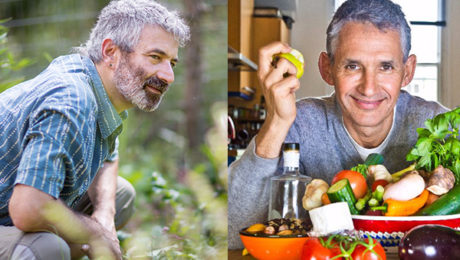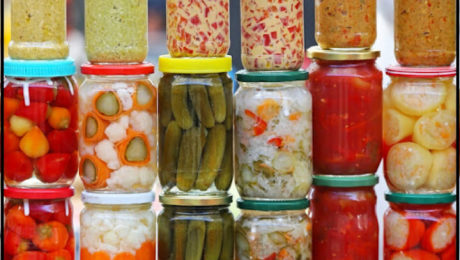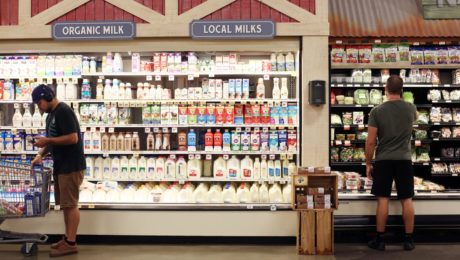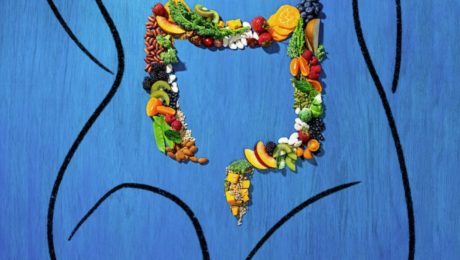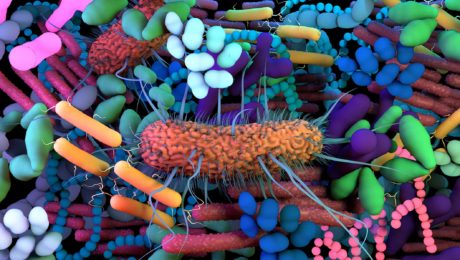“Fermented Foods…Democratize the Science”
Though research about the gut-brain axis is a “growing, pioneering and still relatively novel field,” scientists say humans can improve their mental health by eating a balanced diet rich in fermented foods.
Changes in the gut microbiome can impact the brain’s behavior. Research advancements in the last 20 years “suggest that these (gut) microorganisms aren’t just a vital part of our physical selves, but also our mental and emotional selves, too.” This can be a major breakthrough in how mental health is treated.
For example, one study found individuals with depression have different gut bacteria compared to individuals without depression. Those without depression have a higher amount of bacteria associated with better wellbeing and quality of life. Antidepressants didn’t help. Another study found taking certain probiotic strains improve symptoms of depression and anxiety. And yet another study found taking prebiotics improved the brain’s cognitive function.
But research is still in its early stages. Though some strains of bacteria have been scientifically proven “to have a positive effect on the human mind,” researchers don’t know why and how. Genetics, personality and environmental factors have also not been studied. More large-scale human studies are needed – and those studies are extremely expensive.
In the meantime, John Cryan, a professor of anatomy and neuroscience at University College Cork, encourages people to eat a diet high in fiber, prebiotics and fermented foods. A study by Cryan and his colleagues found that diet
Cryan and his colleagues studies 45 people eating that diet and found they were less stressed than the control group.
“What I like about fermented foods is that they democratize the science,” says Cryan. “They don’t really cost much and you don’t have to get them from some fancy store. You can do it yourself. In this field, we want to provide mental health solutions to people from all socioeconomic areas.”
Read more (BBC)
- Published in Science
Gut Microbes Key to Exercise Motivation
A new study published in Nature reveals some new insight into the gut-to-brain pathway. Certain bacteria types boost our desire to exercise.
The study, performed on mice by researchers at the University of Pennsylvania, found differences in running performance based on the presence of gut bacterial species Eubacterium rectale and Coprococcus eutactus in the higher-performing mice. The metabolites known as fatty acid amides that the bacteria produce stimulate the sensory nerves in the gut, enhancing activity in the motivation-controlling region of the brain.
“If we can confirm the presence of a similar pathway in humans, it could offer an effective way to boost people’s levels of exercise to improve public health generally,” says Christoph Thaiss, PhD, an assistant professor of microbiology at Penn Medicine and a senior study author.
Researchers were surprised to find genetics accounted for only a small portion of performance differences in the mice. Gut bacterial populations were “substantially more important,” reads the study. Giving the mice antibiotics to get rid of their gut bacteria reduced the mice’s running performance by half.
“This gut-to-brain motivation pathway might have evolved to connect nutrient availability and the state of the gut bacterial population to the readiness to engage in prolonged physical activity,” says J. Nicholas Betley, PhD, an associate professor of Biology at the University of Pennsylvania’s School of Arts and Sciences and a study author. “This line of research could develop into a whole new branch of exercise physiology.”
Read more (Science Daily)
Microbes in Cheese
Do you love a mild mozzarella, a salty Parmesan or a funky brie? Thank microbes.
Though the thousands of varieties of the world’s cheeses all begin as a white lump of curd, the diversity is astounding. From the flavor to the color to the texture, cheese goes from “uniform blandness to this cornucopia” thanks to bacteria, yeasts and molds. An article in Smithsonian Magazine – titled The Science Behind Your Cheese – shares the details.
“More than 100 different microbial species can easily be found in a single cheese type,” says Baltasar Mayo, a senior researcher at the Dairy Research Institute of Asturias in Spain.
Scientists have only recently begun to study the microbial nature of cheese. To find out the bacteria and cheese present, scientists extract DNA from the cheese, then match it to genes in the database.
“The way we do that is sort of like microbial CSI, you know, when they go out to a crime scene investigation, but in this case we are looking at what microbes are there,” says Ben Wolfe, a microbial ecologist at Tufts University.
Though cheesemakers often add starter cultures of beneficial bacteria to fresh curds to transform it into a delicious cheese, Wolfe’s team found the microbiomes of the cheese “showed only a passing resemblance to those cultures. Often, more than half of the bacteria present were microbial ‘strangers’ that had not been in the starter culture,” continues the article.
Those “strangers” dumbfounded researchers. Microbes like Brachybacterium found in Gruyère are more commonly found in soil, seawater and chicken litter. Or the Halomonas most commonly found in salt ponds and marine environments. Or, Brevibacterium linens found in damp areas of skin, such as between the toes. Those bacteria come from the environment of the cheesemaking facilities. The microbes come from the cow, goat or sheep, the bacteria in the farm’s stable, the skin bacteria from the hand of the milker, the microbes in the dairy storage tank and/or the sea salt in the brine used to wash down the cheese. Hundreds of bacteria have been detected in long-ripened cheeses.
“Furthermore, by repeatedly testing, scientists have observed that there can be a sequence of microbial settlements whose rise and fall can rival that of empires,” continues the article.
Modern cheesemaking is, sadly, more controlled, meaning modern cheese isn’t as flavorful. Cheesemaking has “become tamer over time,” cleaner and more sterilized, filtered, pasteurized, machine operated.
“Many of our cheddars, provolones and Camemberts, once wildly proliferating microbial meadows, have become more like manicured lawns. And because every microbe contributes its own signature mix of chemical compounds to a cheese, less diversity also means less flavor — a big loss.”
Read more (Smithsonian Magazine)
- Published in Food & Flavor, Science
The Microbes We Should (or Shouldn’t) Be Eating
How important are microbes in the human diet? And does it matter which ones we eat?
“Maybe we’re not too far from proving the following; the dietary guidelines, the My Plate guidelines, should include fermented foods, including those that contain live microorganisms, as part of a healthy diet,” says Bob Hutkins, PhD, a professor at the University of Nebraska (and TFA Advisory Board member). Hutkins explored this hypothesis during his standing-room only presentation at FERMENTATION 2022 titled The Microbes We Should (or Shouldn’t) Be Eating.
He estimates, just like the daily fiber recommendations were granted based primarily on epidemiological studies, fermented foods are going through the same process. And one day there may be a daily fermented food recommendation.
Why Should We Be Eating Live Microbes?
Highly processed foods, prolific use of antibiotics, and overly hygienic environments have resulted in significantly less exposure to microbes. This includes those microbes that help to maintain a healthy gut microbiome and that keep our immune system functioning properly. Indeed, according to the so-called Old Friend’s Hypothesis, exposure to microbes is necessary for proper development of the immune system. This is especially true for Western countries. One highly-cited study published in Lancet found Inflammatory Bowel Diseases (IBDs) like Crohn’s Disease and Ulcerative Colitis — “are predominantly associated with Western populations. You rarely see these diseases in other parts of the world,” Hutkins says.
“In the Covid era, we have certainly learned that preventing infectious diseases remains a major challenge, and being a bit germophobic is understandable. Certainly, modern food technology that includes pasteurization has significantly reduced pathogen risk, improved food safety, enhanced shelf life, and reduced food waste. Nonetheless, our environment has often become too clean, too hygienic and we are no longer exposed to microbes,” he adds.
Another study based on research in Finland found the Old Friend’s Hypothesis holds true for development of allergies, asthma, and eczema. As the authors noted “changes in environment and lifestyle, affecting microbial exposure and immune regulation, seem to play a major role in the so-called post-war allergy epidemic”. Indeed, in a 2002 editorial in the New England Journal of Medicine, three “old-school” lifestyle approaches were mentioned for protecting against the development of allergies: supplementing with lactobacillus (the bacteria found in fermented foods), owning a dog in your home and attending daycare.
Consuming Live Microbes Benefits Human Health
To address this situation, Hutkins and other food scientists are proposing adding fermented foods to the Recommended Dietary Guidelines, along with the daily dose of nutrients and vitamins.
“One of the main challenges however, will be to distinguish between nutrients and microbes,” Hutkins says.
The International Scientific Association for Probiotics and Prebiotics (ISAPP) has explored this further. A panel of ISAPP microbiologists, nutritionists, doctors and statisticians (including Hutkins) used the National Health and Nutrition Examination Survey (NHANES) to deep dive into the American diet. The NHANES database catalogs what adults and children are eating, then collects health indicators for associated diseases.
ISAPP researched the estimated live microbes in foods to find sufficient evidence that a live dietary microbe intake should be a part of a dietary recommendation. It was a big undertaking, since there are 9,388 foods inNHANES. ISAPP ranked each food’s microbial count. They found microbial count was low for processed, heat-processed foods, medium level for fresh fruit and vegetables and high for fermented foods, like fermented dairy (yogurt, fresh cheese) and fermented vegetables.
“Ninety-six percent of the foods we eat are in the low” count for microbes, he said. “Hardly any were in the fermented category, around one percent.”
Still, not all live microbes are the same. The microbes considered healthy – lactic acid bacteria and bifidobacteria – are only dominant in fermented foods. Most of the live microbes consumed in the average diet are proteobacteria from fresh fruits and vegetables.
The Institute for the Advancement of Food and Nutrition Sciences, which catalogs nutrition labels for all USDA food data, now has a space for a brand to enter the amount of live microbes in their product. There’s a dropdown menu to add genus and species of a probiotic strain, too.
“This new effort is a way to introduce the live microbes in the database,” Hutkins says, noting a company would have to enter it voluntarily. “They’re offering a noncompetitive, objective, transparent mechanism for stakeholders to understand live microbe intake and eventually link intake to health outcomes.”
“It’s Not a Niche Type of Food”
The modern consumer is not disconnected with fermented foods, they’re disconnected with the fermentation process. In a discussion between fermentation revivalist Sandor Katz and well-renowned epidemiologist Tim Spector, the two experts agree that, if gut health is going to improve, humans need to eat a diet rich in fermented foods.
“The thing that has disappeared from most people’s lives is familiarity with the process of fermentation. And because it has largely disappeared into factories, we imagine that it must require sterile conditions, require a microscope or a knowledge of microbiology,” says Katz, fermentation author and educator. “We project all of our anxiety about the idea of cultivating bacteria onto the process of fermentation, when in fact fermentation is a strategy for safety and people have been doing it with the simplest of facilities without any knowledge of microbiology for literally thousands of years.”
Katz and Spector, professor at King’s College London and author of the book “The Diet Myth,” discussed fermented foods on an episode of the ZOE Science & Nutrition Podcast. Listener questions revolved around safety. Consumers understand fermented foods are good for them, but are still leery about eating live bacteria.
“Fermentation is the hot craze in fancy restaurants across the western world. But these foods make us uneasy,” said Jonathan Wolf, podcast host and CEO of Zoe. “The idea of letting food rot and then eating it goes against everything our parents taught us. …Five years ago, when I started Zoe, I really had no idea what fermentation was. To be honest, fermented foods sounded like something I would have to throw in the trash.”
Wolf asked Katz why even talk about fermentation if it’s a niche. Katz, credited with revitalizing fermentation in the U.S. and Europe, disagreed.
“Every person in every part of the world eats and drinks products of fermentation almost every day. I’m not sure how you could call that a niche type of food,” Katz said, listing off popular fermented foods: bread, cheese, cured meats, condiments, olives, pickles, coffee, chocolate, vanilla, wine and beer. “Foods that are really everyday foods are products of fermentation.”
Most of today’s consumers are victims of what Katz calls the “war on bacteria…the indoctrination that bacteria are our enemies.” Fermentation, though, is an integral part of foodways all over the world. He adds: “Fermentation is an essential part of how people everywhere have been able to make effective use of whatever kinds of food resources are available to them.”
Healing Foods
Fermented foods and beverages are experiencing a popularity boost in part because of the growing health and wellness trend. Ferments have a high amount of nutrients and live microbes, which improve gut health. While there are some cases of proven health benefits of consuming fermented foods, Spector points out fermented foods have not all been fully tested.
Still, there’s enough evidence to indicate we should be eating fermented foods. Korea, Spector says, has one of the healthiest westernized populations. They’re eating an average of 36 kilograms a year per person. That’s an extra probiotic supplement of 20 species, including yeasts and fungi, things you won’t find in a health food store, Spector says.
“It helps your gut microbes (because)…you’re getting the prebiotic and the probiotic. The fertilizer and the seeds both at the same time,” Spector says. “That’s what’s unique about those sorts of types of fermented vegetables that we don’t often talk about. And that’s probably why they potentially have greater health benefits than just the pure microbes on their own. … It’s that double system of both feeding the original contents of your gut microbes, stimulating new ones to grow more of the good guys, and consuming these probiotic microbes that don’t live in humans. Just passing through has a beneficial effect.”
Spector compares those commensal microbes to a rich, American cruise ship passing through a poor, island community. They come in, spend loads of money to dispense through the local economy, then leave.
Live vs. Shelf Stable Products
Though products like bread and sauerkraut are fermented, that doesn’t mean all bread and sauerkraut are fermented. Highly processed, shelf-stable versions kill off the beneficial live microbes.
“There’s been an explosion in the UK of things like kefirs and kombuchas that you can buy in stores, and there’s a suspicion that many of them do not contain live microbes,” Spector says. Brands use ultra-fine filtration systems to get rid of microbes; they pasteurize products to ship it around the country; they add lots of sugars that inhibit the microbes; they make vinegars with such high acidification that it kills the microbes and the mother.
“It’s great to have these products, but I feel they could be exploited,” he adds.
Spector said there’s not a word for a true fermented food yet – he suggested using the term “live fermented food” – so consumers need to read labels at the grocery store. A kefir or kombucha can have between 10-30 varieties of microbes, but you may only be getting only one depending on what brand you buy.
Live ferments will generally be in the refrigerated food section. Heat processed, shelf stable foods are usually on the grocery store shelf.
Katz encourages consumers to steer away from bigger, national brands when purchasing ferments and instead buy from smaller, regional brands who don’t need to process their ferments to ship.
“The more educated you are, the more quality products you can find,” he says, advocating for people to research their food.
He points out the trend of the “lightly fermented soft drinks” can fool consumers, too. These drinks often have a high sugar content with no real benefit to the microbiome, Katz says. Though they can be a great replacement for traditional, sugar-filled sodas, you’re still drinking a lot of sugar.
“Anything sugar-sweetened, you really want to exercise restraint and moderation,” he says.
Katz ended the podcast with his five tips for anyone wanting to try fermented products.
- Don’t be afraid to try it. Katz: “Do not project all of the anxiety you’ve ever had about bacteria onto the process of fermentation. Understand that these are ancient practices that have been tested over time and that they are extremely safe.”
- Understand the conditions. Fermentation is about manipulating the environment for optimal growing conditions. Understand what they are to support lactic acid bacteria and avoid spoilage organisms.
- Don’t overthink it. Accept the simplicity of the fermentation process. Don’t obsess over what could go wrong.
- Experiment. Katz points out there are unlimited variations of fermented food combinations. “Don’t be afrait to play around.”
- Be creative. There are many fermented foods to incorporate in the diet. The hard part for beginners is getting accustomed to them. Try combinations that work for you – kimchi on eggs or pickles in salad dressings, for example.
- Published in Food & Flavor, Health
Fermented Foods Reduce Stress
Researchers have made a breakthrough discovery in stress management: fermented food can change one’s mood.
Scientists from the University College Cork (UCC) APC Microbiome research center found consuming 2-3 servings of fermented foods a day – like sauerkraut, kefir, kimchi, kombucha, yogurt, etc. – improves mental health. Stress and depressive symptoms are reduced when regularly consuming fermented foods.
Their month-long study analyzed the effects of a psychobiotic diet on adults, while the control group was given general nutrition advice in line with the food pyramid. The psychobiotic diet is designed to target the gut microbiome. It includes fermented foods, fruit and vegetables high in prebiotic fibers, grains and legumes.
“Although the microbiome has been linked to stress and behavior previously, it was unclear if by feeding these microbes demonstrable effects could be seen,” said Professor John Cryan, one of the study’s lead authors, vice president for research and innovation at UCC, and a principal investigator at APC Microbiome. “Our study provides one of the first data in the interaction between diet, microbiota and feelings of stress and mood. Using microbiota targeted diets to positively modulate gut-brain communication holds possibilities for the reduction of stress and stress-associated disorders, but additional research is warranted to investigate underlying mechanisms.”
Researchers studied participants with relatively low fiber diets, measuring their perceived levels of stress before and after beginning the psychobiotic diet. Four weeks in, participants reported a strong decrease in perceived stress. Their sleep improved, too. Forty chemicals were affected by the change,
“These results highlight that dietary approaches can be used to reduce perceived stress in a human cohort. Using microbiota-targeted diets to positively modulate gut-brain communication holds possibilities for the reduction of stress and stress-associated disorders,” the study reads.
Cryan, in an article for The Telegraph, said: “The mechanisms underpinning the effect of diet on mental health are still not fully understood. But one explanation for this link could be via the relationship between our brain and our microbiome (the trillions of bacteria that live in our gut). Known as the gut-brain axis, this allows the brain and gut to be in constant communication with each other, allowing essential body functions such as digestion and appetite to happen.
“It also means that the emotional and cognitive centres in our brain are closely connected to our gut.”
He added: “The next time you’re feeling particularly stressed, perhaps you’ll want to think more carefully about what you plan on eating for lunch or dinner. Including more fibre and fermented foods for a few weeks may just help you feel a little less stressed out.”
The study was published in Molecular Psychiatrry.
Educating Consumers About Fermentation
Fermentation continues to top food trend lists, health movements and restaurant menus, influencing more curious consumers to buy fermented foods. But the average consumer remains fermentation clueless.
“Fermentation is a really complicated subject and we’re just reaching the tip of the iceberg at this point when it comes to the research,” says Jenna Mills, account manager at Eat Well Global, a food and nutrition consulting agency. “A complicated subject like this is loaded and I feel that individuals and consumer know just enough to be confused.”
Five food professionals shared their thoughts on how to educate consumers about fermentation during a panel at FERMENTATION 2022. Panelists included: Mills, Shannon Coleman (associate professor and state extension specialist at Iowa State University), Matt Lancor (CEO and founder of Kombuchade), and Kirsten Shockey (author, educator and co-founder of The Fermentation School and TFA Advisory Board member). Amelia Nielson-Stowell, editor at The Fermentation Association, moderated.
Simple Messaging
The panelists agreed fermentation brands need to stop overcomplicating fermentation to the consumer, focusing on simple communication strategies.
“I compare it to a small child asking where babies come from – a simple answer is enough,” says Shockey. “With fermentation, often, we’re ready to say that lactic acid bacteria come in and they’re eating carbohydrates and there are these metabolites and flavors involved. We’re ready to share all the details – and we’re met with a blank stare. People just often want to know what’s the difference between a pickle and a ferment.”
Shockey, who teaches at the women-run Fermentation School, says she’s felt pressure over the years to innovate her classes and teach new subjects. But, especially since the Covid-19 pandemic when more consumers focused on health and turned to fermentation, her most popular classes are still the basic fermentation 101.
In a TFA survey last year, 70% of fermentation producers said a greater understanding of fermentation and familiarity with the flavors associated with fermentation would foster increased consumption of fermented foods.
Kombuchade is taking a unique approach to that education component, focusing on kombucha as a recovery drink.
“I’m looking to make probiotics cool for athletes, much like Gatorade made electrolytes cool for athletes,” Lancor says. The science of food is typically a mechanical process: eat fats, carbohydrates and proteins for optimal energy and performance. “There’s actually a microbial fermentation process that’s helping to rebuild your muscles.”
Kombucha marketing is geared toward a yoga, enlightenment crowd, Lancor adds, only reaching a certain number of consumers. It doesn’t resonate with all consumers.
“The south side of Chicago guys that play on my rugby team, they were never going to grab that kombucha bottle off the shelf with that kind of messaging,” he says. “There wasn’t this message of probiotics can be used for performance or recovery or even understanding kombucha’s place within an athlete’s regimen.”
Communicating Science & Tradition
Fermented food brands are tasked with bridging the gap between science and consumer.
Consumers keep informed about food and nutrition trends through professional associations (69%), academic (67%) and dietitians and nutritionists (62%), according to a consumer insights survey by Eat Well Global.
For 77% of consumers, the advice of dietitians and nutritionists impacts which foods they buy. Mills says healthcare professionals offer that counseling on how to incorporate fermented foods into the diet.
Don’t forget the ancestral wisdom, Shockey points out.
“My one liner is we’ve evolved with these foods and you are here because your ancestors successfully fermented,” she says. Rather than educating that people should eat a tablespoon of sauerkraut a day to meet nutrition needs, “try to bring it into your world naturally.” Eat a mixture of ferments, with yogurt at breakfast or hot sauce at lunch and kimchi at dinner.
“We cannot put ferments into this box that must be eaten raw. That to me is a barrier. You should eat this in any way that feels right to you,” she says, adding ferments were traditionally eaten cooked in soups and stews. “But in our minds right now is the idea that we have to eat our probiotics raw. These foods have so many metabolites that are being created in production and they follow through in the cooking process.”
Challenges to Starting a Brand
Starting a fermentation brand can be an overwhelming task. Sandor Katz, fermentation author and educator, said in his keynote address at the FERMENTATION 2022 conference that education is a huge challenge for people launching new fermented products.
“They often end up putting a lot of their energy into educating consumers,” he says.
Coleman says state extension offices are an underutilized resource for new producers. Her office got into food preservation after noticing many Pinterest recipes that gave poor advice on food safety.
“Just about every extension program has some form of food preservation type of program that they are delivering to consumers and they want to help,” Coleman adds.
There are no universal standards for labeling, an obstacle for new producers.
“Labeling is such a sensitive issue because you can get into big trouble with the FDA,” Nielson-Stowell says, pointing out the U.S. Food & Drug Administration only has 12 approved health claims a brand can put on a label. “It also gets tricky putting ‘probiotic,’ ‘prebiotic’ or ‘postbiotic’ on a label. It’s not regulated and confusing to consumers.”
The International Scientific Association of Probiotics & Prebiotics (ISAPP) is pushing for -biotics to be a more protected term. According to ISAPP, only fermented food brands with a scientifically measured -biotic should but it in a label. Their health benefits must be documented. For example, yogurts often have defined probiotic strains on their labels.
Nielsen-Stowell recommends using “live cultures,” “live microbes” or “naturally fermented” instead. And make sure retailers know what that means.
“If you’re getting your set in store with a retailer, the retailer will be your biggest advocate. The retailer is going to be the one talking to the customers more than you. Educate them. Do they know why your product is better than your competitor’s product?” she adds.
Nourishing Microbiota With Fermented Foods
The gut microbiome and how fermented foods can nourish it topped the Washington Post headlines in September. The article shared highlights from the growing number of studies that suggest “these vast communities of microbes are the gateway to your health and well-being — and that one of the simplest and most powerful ways to shape and nurture them is through your diet.” Food (and environment and lifestyle behaviors) have a much larger impact on the gut microbiome than genetics.
The article by health reporter Anahad O’Conner says science proves diverse diets make diverse gut microbiomes. Lower rates of microbiome diversity is linked to chronic diseases like obesity, diabetes and rheumatoid arthritis.
One way to increase that diversity is by eating fermented foods – the article points out yogurt, kimchi, sauerkraut, kombucha and kefir as excellent examples.
“The microbes in fermented foods, known as probiotics, produce vitamins, hormones and other nutrients. When you consume them, they can increase your gut microbiome diversity and boost your immune health, said Maria Marco, a professor of food science and technology who studies microbes and gut health at the University of California, Davis.”
A study by researchers at Stanford – and published last year in the journal Cell – found people who eat fermented food regularly increase their gut microbial diversity and lower their levels of inflammation.
“While it’s clear that eating lots of fiber is good for your microbiome, research shows that eating the wrong foods can tip the balance in your gut in favor of disease-promoting microbes,” writes O’Connor. The “bad” microbes, according to research, are commonly found in highly processed foods “that are low in fiber and high in additives such as sugar, salt and artificial ingredients. This includes soft drinks, white bread and white pasta, processed meats and packaged snacks like cookies, candy bars and potato chips.
Tim Spector, professor of epidemiology at King’s College London and the founder of the British Gut Project, tells the Washington Post that eating a wide variety of plants, fiber and nutrient-dense foods is also beneficial for the gut. Spector encourages people to eat 30 different plant foods a week, which can include produce, nuts, herbs and spices.
Read more (The Washington Post)
Harnessing the Power of the Microbiome
A team of nearly three dozen researchers from around the world reviewed case studies on microbiome research in agrifood systems. Their results, published in the journal Frontiers in Microbiology, “showcase the importance of microbiome research in advancing the agrifood system.”
Their 14 success stories include a broad range of topics within agrifood:
- Microbial dynamics in food fermentation
- Using microorganisms as soil fertilizers
- Applications to improve HACCP systems
- Identification of novel probiotics and prebiotics to prevent disease
- Using microbiomes of fermented foods for starter cultures
- Fermenting feed to improve the microbiomes of livestock
- Identifying microbes in fermented meats
- Using microbiota analysis for fermented dairy products
To further microbiome use in food systems, the research points to studies highlighting that fermented foods include many health-promoting metabolites (including studies by TFA Science Advisory Board member Maria Marco, a University of California, Davis, food science professor). But, the researchers stressed: “How certain microorganisms drive food fermentation, are transferred across the food production chain, persist in the final product and, potentially, colonize the human gut is poorly understood.” Researchers conclude that more work is needed to understand how the probiotics and metabolites in fermented foods could be used to treat diseases.
“Agrifood companies recognize the potential in understanding the microbiome and translating this knowledge into products,” the study continues. The food industry, the study notes, is “further preparing to develop personalized diets and specific foods for particular target groups in order to prevent or treat certain chronic conditions.”
“The microbiomes of soil, plants and animals are pivotal for ensuring human and environmental health. Research and innovation on microbiomes in the agrifood system are constantly advancing, and a better understanding of these microbiomes will be a key factor in producing highly nutritious, affordable, safe and sustainable food.”
Read more (Frontiers in Microbiology)





